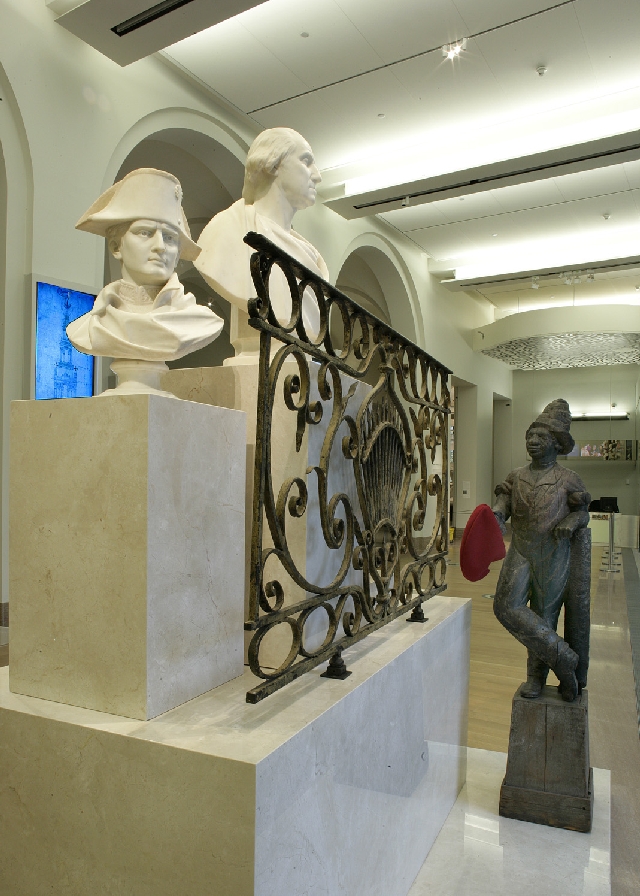"Slavery," historian James Oliver Horton wrote in 2006, "was not a sideshow in American history. It was the main event." So why has a work by the African-American artist Fred Wilson -- an installation piece that riffs on the topic by assembling authentic slave shackles, slave chains and Revolutionary-era icons -- been such a sore point with critics?
Conceived especially for the New-York Historical Society, Wilson's Liberty/Liberté was our unquestioned choice to be the first thing that visitors would see when they came into our renovated building. Our ground floor would now offer the first overview we have ever presented, in more than 200 years in operation, of the themes and collections of our Museum. Our building would now reveal these new galleries immediately to visitors, thanks to a glass-walled entrance lobby. And facing the visitors through the glass wall, as soon as they came in the door, would be this large, complex installation by Wilson, made entirely with objects from New-York Historical and from its resident Gilder Lehrman Collection.

What happened when we threw open the doors last November? Critics universally praised our ground-floor galleries -- and complained about Wilson's installation. Obviously, we had struck a raw nerve. To explain how, and why, let me tell you a little about the artist and what he has done.
Born in 1954, Fred Wilson is one of the best-known American artists of his generation. For the past twenty years, he has created engaging, thought-provoking artworks with the lightest touch imaginable by ingeniously reshuffling the objects he finds in the permanent collections of museums. He has been recognized with a MacArthur Foundation "genius grant" and in 2003 he represented the United States as our nation's official artist at the Venice Biennale.
For New-York Historical, Wilson arranged his chosen objects on and around a large marble stand made with pedestals of varying heights. Among the pieces that Wilson assembled for Liberty/Liberté were two sculptures of George Washington (one showing him in the toga of an ancient Roman republican, the other in the garb of a Virginia gentleman farmer); a cigar-store figurine of an African-American man holding a red French liberty cap; a bust of Napoleon Bonaparte; a miniature portrait of Haitian liberator Toussaint L'Ouverture; a wrought-iron balustrade from Federal Hall in New York, where Washington was sworn in as the first President; chains, shackles and slave badges (the metal tags that were used to label enslaved African Americans with the crafts they practiced); and a tag bearing Sojourner Truth's famous question, "Ain't I a woman?"
What did our critics make of this assemblage? They voiced two main complaints: Wilson's piece had no readily discernible meaning, and its meaning was far too obvious.
Liberty/Liberté is "enigmatic," one critic wrote. "What is it about? Slavery? Tyranny? The Constitution? No clear answer is given to the puzzled onlooker." Another critic thought he knew exactly what the piece meant -- and didn't like it. "In recent exhibitions," he wrote, "the society has explored some troubling aspects of New York's past, but the presentations were nuanced and enlarging. Here, though, we see only a placard. We want to think highly of our once-worshiped gods? Hypocrites, slave holders, oppressors!"
Because Wilson's installations are in effect high-art Rorschach blots, these judgments tell us more, perhaps, about how touchy the topic of American slavery still is than about Liberty/Liberté. Could it possibly be that Wilson had something in mind other than the simple-minded intention to debunk and condemn? Could it also be possible to connect slavery, tyranny, and constitutional government -- and that Wilson is doing just this in his work?
In fact, though, Wilson in Liberty/Liberté is doing nothing more than New-York Historical's curators have done elsewhere throughout the galleries, or that researchers do every day in New-York Historical's Library. Wilson has reached into the trove of evidence left to us by past centuries. He has selected; he has juxtaposed; and in so doing, he has given us one possible interpretation of what happened in history. Where Wilson differs from the others is that he leaves much of this interpretation to the viewers. In essence, we become the curators and researchers.
That's why we believe Liberty/Liberté is really an ideal introduction to New-York Historical's galleries. It has the potential to get everyone thinking like an historian. And that's also why the criticism of Wilson's installation is so interesting. When it comes to the "main event" in American history, our nerves are still very raw.
